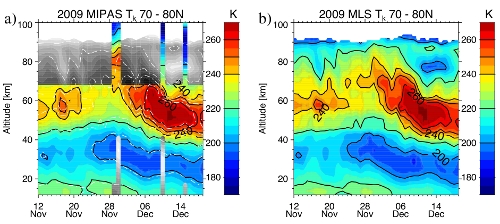First detection of a Brief Mesoscale Elevated Stratopause in very early winter

MIPAS and MLS observed a highly zonally-asymmetric Arctic stratopause at high altitudes in November 2009 accompanied by a strong descent. The event has similarities with typical elevated stratopause events but it is of smaller scale in terms of duration and extent. The figure shows temperature time series for MIPAS (a) and MLS (b) at longitude 10-80o W and latitude 70-80o N for late Autumn 2009.
Elevated stratopauses are typically associated with prolonged disturbed conditions in the northern hemisphere polar winter. MIPAS and MLS observed a short-lived and highly zonally asymmetric stratopause at mesospheric altitudes in November 2009, the earliest in the season reported so far. The Arctic climatological winter stratopause vanished and MIPAS and MLS measured temperatures of 260 K at 82 km and 250 K at 75 km, respectively, in a region smaller than in typical mid-winter elevated stratopause events. Planetary wave activity was initially high. Zonal mean zonal winds and the poleward temperature gradient northward of 70o N stayed reversed during 7 days. The mesosphere did not cool during that phase. Wave activity dropped until the eastward stratospheric zonal winds resumed and a strong vortex restored in the mesosphere. The stratopause emerged at a high altitude, staying there for 2-5 days. It was accompanied by enhanced downward transport. It took the stratopause 9 days to move down to its typical winter altitudes.
For more information see: https://doi.org/10.1029/2019GL086751
